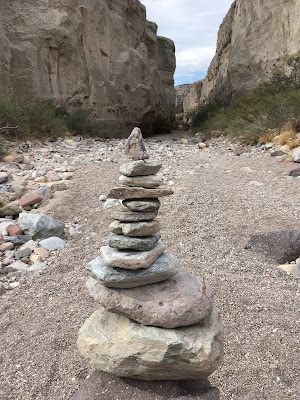
We have long been planning to visit
Fort Davis National Historical Park, where Mike worked a 2 week
detail as a seasonal law enforcement ranger 13 years ago. We set off
on Thursday, passing through Terlingua, then Lajitas (quite an
attractive little town which features a golf course, made possible by
its proximity to the Rio Grande, and also has 2 caged goats which are
deemed to be the mayors of the town), and then into Big Bend Ranch
State Park. The road through the park is scenic and surprisingly
topsy turvy, almost as if our car was on a roller coaster. We hiked
the Closed Canyon trail, which was quite challenging and fun. The
canyon gradually narrowed and descended to a point where it must have
become dangerous, because it was closed to further exploration.
Jasper had a ball rock hopping and climbing on the walls.

From there, we drove to Fort Leaton
State Historic Site, which is part of the same state park. It was an
interesting old adobe structure with some furnished rooms,
interpreting the lifestyle of the families that lived there in the
1800s. It's one of the largest and best maintained historic adobe
structures in Texas, and provides a glimpse of life at a fortified
trading post on the US-Mexico border beginning in the turbulent
mid-1800s. There was a fairly large enclosed area where the cattle
were kept at night, to prevent them from being stolen, and a
humongous ox-cart, which was so large it was sometimes pulled by a
dozen oxen.
Our next stop was a spontaneous visit
to a Mexican panaderia (bakery) in Presidio. I was the only
English-speaker inside, and they seemed a little taken aback at my
presence. I could tell they were relieved when I spoke little bits of
Spanish. The baked goods were all beautiful and looked very
appealing. We had some of them for breakfast the next morning.
By the time we pulled into the town of
Fort Davis, the sun was setting. We were hungry and nearing the point
of crankiness when we saw a Mexican Restaurant and quickly decided to
eat there. We chose to sit outside on the patio, as nobody inside was
wearing a mask. It was our first visit to a restaurant (other than a
few take-outs) since last March, due to COVID precautions. The food
was quite good and very filling, Mike's fajitas in particular.
About an hour after dark, we arrived at
our campsite in Davis Mountains State Park. We had expected to have
close neighbors, as all the sites showed that they were reserved
online, but there must have been a lot of cancellations. We set up
our tent in the darkness, enjoyed looking at the stars as we walked
through the campground, and then climbed into the tent to read for an
hour before falling asleep.

The next morning, after our traditional
breakfast of oatmeal and supplemented by the Mexican pastries, we
drove up the Skyline Drive, in the park, where we enjoyed 360 views
of distant mountain ranges. Our next stop was Fort Davis NHS. From
the website, “Fort Davis is one of the best surviving examples of
an Indian Wars' frontier military post in the Southwest. From 1854 to
1891, Fort Davis was strategically located to protect emigrants, mail
coaches, and freight wagons on the Trans-Pecos portion of the San
Antonio-El Paso Road and on the Chihuahua Trail.” We took a short
hike to a viewpoint, where we could look down on the “parade
grounds” where the soldiers practiced marching and conducting
drills. Several of the houses were beautifully appointed with antique
furniture, uniforms, and other items such as medical equipment (in
the hospital). Signage told the stories of inhabitants who were
killed, either by disease (quite common) or violence (much less
common, since the fort was never actually attacked). Occasionally the
sound of bugles would break the silence, representing the call to
meals, change of guard, and various horse-related chores typical of
the fort when it was inhabited. During non-COVID times, even more
buildings are open to the public, and the historical reenactments
would add a lot to a visitor's understanding of the fort's
significance. I'd definitely recommend a visit.




Shared officers' quarters at Fort Davis NHS.
Some of the buildings (like this one, the Commanding Officers' home) are furnished and open to the self-guided tour (even during COVID times).
A glimpse into the fort's old pharmacy. I always think old medicine bottles are interesting. Hearing about the antiquated methods of surgery make me VERY glad to live in modern times!
In the afternoon, we drove the 75 mile
Davis Mountain scenic loop and stopped at the McDonald Observatory
for a self-guided tour of the visitor center and surrounding area.
Most of the exhibits were closed due to COVID, so it was a little
disappointing, but we did get an idea of what type of research they
do, using the telescopes. The drive was pretty and we felt
appreciative of the lack of development on the private lands. We
stopped for a short hike at Madera Canyon, on Nature Conservancy
land, then finished the drive and had a picnic dinner along Skyline
Drive as the sun set on another busy day.
Our visit to that region was
interesting and worth a couple more days, to be able to fully explore
the trails, visitor centers, and towns along the way.
































